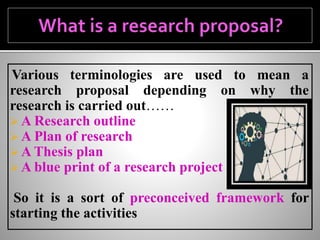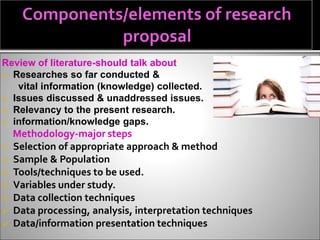How to write a Research proposal?
- 2. A research proposal is a format and detailed statement of intent of the researcher. A research proposal presents and justifies a plan of action and shows the investigation plan. A research proposal is a document written by a researcher that provides a detailed description of the proposed program. It is like an outline of the entire research process that gives a reader a summary of the information discussed in a project plan.
- 3. In short, a researcher is proposing a work frame for completing his/her research.
- 4. Various terminologies are used to mean a research proposal depending on why the research is carried out…… A Research outline A Plan of research A Thesis plan A blue print of a research project So it is a sort of preconceived framework for starting the activities
- 5. A Research Proposal deals with ideas of a researcher about what the researcher wants to do… what objectives and methodology he/she has set… how much time and resources are required to complete it… how the research findings are to be reported… and all the other required details …
- 6. Researcher can- Identify problems/barriers & think over to remove it. Think over the different aspects of the research process & find out shortfalls. Evaluate own work. Get suggestions, guidance & opinions from experts.
- 7. Researcher can- Decide the nature of guidance to be get from the guide. Avoid wastage (of time, efforts & money). Assure success. Avoid failure & related frustration. Apply for registration. Get research funding/grants.
- 8. Parts of the proposal
- 9. Name of the researcher Name of the Guide Year of the study & centre Degree Title
- 10. TheTitle should Reflect the theme of the research. Be written in a simple and unambiguous language Be Brief but self-explanatory. Be specific to a particular domain. Avoid bracket, arithmetic figures etc. Avoid confusing meaning.
- 11. Introduction --should include Thereoretical background Background of the problem (Should also address the need ) Statement of the problem -- Should elaborate Nature of the problem. Explanation of the Problem. Justification & urgency to solve it.
- 12. Significance (Rationale/justification) of the research Importance Addressing the context of the problem Bridging the knowledge gaps Usefulness to the society/community Present state of affairs Affected stakeholders Objectives of the research- (Major steps) Should be Contextual/consistent to the title Concise, clear-cut, expressed in a simple language Precise, self-explanatory Distinctive, quantifiable/ measurable Two types of objectives : general/broad/overall & specific
- 13. Operational definitions of terms used Clear-cut /actual meaning. Meaning of the terms as considered by the researcher. Assumption The things researcher believes to be facts but cannot verify. Hypothesis =Tentative answer of the problem or an educated hunch. Proposition subject to verification May be directional/non directional Guides/leads the research
- 14. Limitations of the study –Things beyond the control. Shortcomings of the research – may be related with resources, sampling, standardized tools and time constraints Delimitations of the study—decided by the researcher Boundaries of the research Area, level, standard, medium, subject etc.
- 15. Review of literature-should talk about Researches so far conducted & vital information (knowledge) collected. Issues discussed & unaddressed issues. Relevancy to the present research. information/knowledge gaps. Methodology-major steps Selection of appropriate approach & method Sample & Population Tools/techniques to be used. Variables under study. Data collection techniques Data processing, analysis, interpretation techniques Data/information presentation techniques
- 16. Time schedule Time line of the assigned tasks. Time line of the research flow . Budget/estimated cost- Cost built up – resource personnel, support staff, technical support , stationery, transport, utilities, miscellaneous etc
- 17. Chapterization chapters’ outline In Social Studies or in the education field generally five chapters are expected. 1 Chapter one Introduction 2 Chapter two Review of Related Literature & Researches 3 Chapter three Methodology 4 Chapter four Analysis of Data 5 Chapter five Summary ,Conclusion & Discussion , Recommendations.
- 18. Bibliography/References Researcher should Mention all the related documents consulted/studied. Follow technicalities in writing bibliography/ references. Present it in an alphabetic order in a very systematic manner, using recommended standardized style like APA style.
- 19. A good proposal hinges on a good idea. Proposal helps you estimate the size of a project. Proposal writing is important for the pursuit of a particular degree. A clean, well thought-out proposal forms the backbone for the thesis itself. It guides your journey from Proposal to –research process & then to- the thesis writing. A vague, weak or fuzzy proposal can lead to a long, painful, and often unsuccessful thesis writing exercise.
- 20. Try to convince that you have a worthwhile research project as well as the competence and the work-plan to complete it. It should contain all the key elements of the research process and include sufficient information to evaluate it. Regardless of your research area and the methodology you choose, all research proposals must address the following questions: What you plan to accomplish? Why you want to do it and ? How you are going to do it?
- 21. Produce/prepare a professional looking proposal . Make it interesting . Make it informative, meaningful . Write in simple language. Use clear headings/sub-headings. Be concise, precise. Check spelling, grammar. Present in accurate/acceptable format. •Use no word which you do not understand. •Un necessary Use of difficult language unimpressive to the readers/supervisor/ authority .
- 22. Write the proposal in future tense. Be careful about spelling & grammar. Use easy but scientific language. Be precise. Give references wherever necessary. Follow the technical norms of writing a proposal Don't make it too lengthy.(About 15 to 20 Pages are sufficient for a Ph.D. proposal)
- 23. References Best,J.W.and Kahn,J.V.(2006) Research in Education(9th Edition). New Delhi: Prentice Hall of India Pvt Ltd. Gay.L.R.(1992). Educational Research. New Jersey: Prentice Hall of India Goods and Scates (1979). Introduction in Research in Education, New York., Halt Rinehart and Winston Kaul, Lokesh (1993).Methodology of Educational Research, (2nd revised edition), New Delhi,Vikas Publishing House Pvt.Ltd. Mouley,J.W.(1964).”The science of Educational Research”. New York.Van Nostrand Reinhold Comp.























